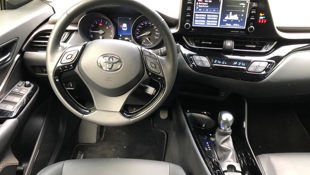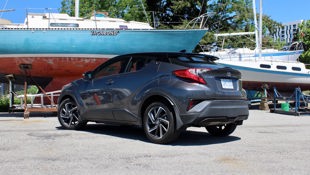 AutoTrader SCORE
AutoTrader SCORE
-
STYLING8/10
-
Safety8/10
-
PRACTICALITY6/10
-
USER-FRIENDLINESS8/10
-
FEATURES8/10
-
POWER6/10
-
COMFORT8/10
-
DRIVING FEEL8/10
-
FUEL ECONOMY9/10
-
VALUE8/10
Introduced five years ago, the subcompact Toyota C-HR took the marque’s “no more boring cars” mandate to heart, rocking origami sheet metal and a palette of bright colours to match.
Originally slated to be a Scion model, the death of that youth-oriented sub-brand brought this radical crossover to the Toyota lineup. While other markets have access to four-wheel traction and a hybrid powertrain, the front-wheel-drive 2022 Toyota C-HR soldiers on unchanged.
Styling: 8/10
Beauty is certainly in the eye of the beholder here. The top-trim Limited rides on handsome 18-inch alloy wheels, giving it an athletic stance, while this tester’s Magnetic Grey paint paired with a black roof tones down the radical styling at least a little. The dramatically raked rear roofline is capped with a big spoiler, and the rear door handles are found in the upper corners where they blend into the massive C-pillars. The C-HR is either delightfully funky or willfully overstyled. We’ll go with the former, as it’s better to make a statement than none at all.
Safety: 8.5/10
Standard with all C-HR trims is Toyota’s comprehensive safety suite that includes adaptive cruise control that works in stop-and-go traffic, automatic high-beam headlights, forward collision warning with pedestrian and bicycle detection, automatic emergency braking, lane-tracing assistance, and lane departure alert with steering correction. The latter gets intrusive at times, and the pre-collision warning can get tricked and is easily triggered.
Standard LED lighting delivers crisp nighttime visibility. The Limited gets blind-spot monitoring and rear cross-traffic alert. The 2022 Toyota C-HR is named Top Safety Pick by the Insurance Institute of Highway Safety (IIHS).
Practicality: 6/10
The C-HR sacrifices functionality on the altar of eye-catching (searing?) sheet metal. Its dramatically sloped roofline cuts into cargo space, and the thick C-pillars severely hamper rearward visibility. Back-seat passengers get a cave-like experience, and smaller kids won’t be able to see out the windows at all.
Open the big hatch and the load floor is high compared with most rivals, while the 538 L of space pales in comparison to the Honda HR-V’s 688 L. The 60/40 split rear bench must be folded down to carry anything of substance. At least the floor is flat when they’re stowed. Cabin storage is wanting, with its two small cup holders and a modest cubby in the centre console.
User Friendliness: 8/10
The Toyota C-HR, as with most Toyota products, benefits from sensible ergonomics that promote easy familiarity. While the eight-inch touchscreen’s graphics look a bit dated, its menu structure is clear and logical, and present are both volume and tuning knobs for quick audio manoeuvring. A vertical row of hard buttons to the left of the screen calls up the main infotainment displays. HVAC functions are controlled by a stretch of well-marked toggles and buttons, and gears are selected by a mechanical P-R-N-D shift lever.
Features: 8/10
This being the top tier model, the C-HR Limited comes reasonably well equipped. Along with the aforementioned safety kit, the Limited adds leather upholstery, a proximity key, and power-folding mirrors with approach lights that project a groovy C-HR logo onto terra firma. Ambient lighting adds an element of class to the nighttime cabin. Toyota speaks of the “sexy diamond” theme, and this motif is echoed in the air vents, speaker covers, button clusters, door panel pattern, and some embossing on the headliner.
The front seats are heated and the driver gets eight-way power adjustability. The standard leather wheel has Land Rover-grade hide, and the doors (with nicely padded pulls) close with solid authority. Standard in all C-HR models are dual-zone climate control and an adequate-if-not-outstanding six-speaker audio system that supports Apple CarPlay and Android Auto. You won’t find a sunroof or heat for the rear seats in the C-HR.
Power: 6.5/10
Power comes from a 2.0L naturally aspirated four-cylinder that puts out 144 hp and 139 lb-ft at 3,800 rpm. Transmission duties are handled by a continuously variable transmission (CVT) featuring seven programmed steps designed to mimic the feel of a “normal” automatic. It’s a pretty tepid combo that works hard to drum up meaningful trust when called upon.
At 1,497 kg (3,300 lb), the C-HR is a porker for this class, and you can feel the four-pot working against this when merging or trying to pass. When your foot hits the floor the CVT sets the engine into drone-mode while the car plays catch-up. However, power output is acceptable for day-to-day puttering about, and once settled into a pace the C-HR’s cabin is decently serene thanks to Toyota’s targeted sound insulation.
Comfort: 8/10
Front-seat occupants enjoy plenty of leg- and headroom, while those in the second row do not fare quite so well as legroom trails most rivals. As noted, rear-seat ambience falls into the cave-like category thanks to the pinched side windows. The front leather seats are comfortable and well contoured, and the C-HR serves up a firmly composed and mostly compliant ride, with only the sharpest impacts upsetting the calm.
Driving Feel: 8.5/10
Lack of power aside, the C-HR is a pleasant thing to drive, showing a sense of dynamic poise and refinement that, at the time of its launch, signalled a new direction for the automaker. It was the first North American vehicle to use Toyota’s lighter and stiffer scalable architecture. With front struts and a multilink rear suspension, the C-HR successfully combines fine body control and flat cornering with a firm yet composed ride. Steering is accurate and natural, and the brake pedal progressive.
Fuel Economy: 9/10
My week of mostly highway driving netted 7.1 L/100 km, handily beating the official fuel economy numbers of 8.2 combined. Granted, I was driving with a light right foot (inspired by gas prices of more than $2/L), but it shows that, driven with a modicum of restraint, the front-wheel-drive C-HR can be a sanctimonious fuel sipper.
Value: 8/10
2022 Toyota C-HR pricing starts at $24,350 plus an $1,890 freight charge for the base LE with a fabric interior and 17-inch steel wheels, yet its mechanicals and infotainment match those of this top-trim Limited. Also standard is the comprehensive safety suite that includes full-speed adaptive cruise control.
Moving up to the $26,890 XLE Premium nets blind-spot monitoring with rear cross-traffic alert, 18-inch alloy wheels, and interior trim upgrades. If you don’t need the leather and the few other baubles of the $29,350 Limited, the XLE Premium is the sweet spot of the C-HR lineup.
The Verdict
The 2022 Toyota C-HR is a fine driving and impressively economical subcompact crossover that’s hampered by radical styling that puts a hit on practicality. This fact is reflected in the small Toyota’s low standing on the sales chart. The front-wheel-drive Nissan Kicks and Hyundai Venue have more usable cargo space and better visibility, and some rivals like the Honda HR-V offer all-wheel drive, too, making this an interesting choice but not our first.
| Engine Displacement | 2.0L |
|---|---|
| Engine Cylinders | I4 |
| Peak Horsepower | 144 hp @ 6,100 rpm |
| Peak Torque | 139 lb-ft @ 3,900 rpm |
| Fuel Economy | 8.7 / 7.5 / 8.2 L/100 km cty/hwy/cmb |
| Cargo Space | 538 / 1,031 L seats up/down |
| Model Tested | 2022 Toyota C-HR Limited |
| Base Price | $29,350 |
| A/C Tax | $100 |
| Destination Fee | $1,890 |
| Price as Tested | $31,880 |
|
Optional Equipment
$540 – Black Roof, $540
|
|





























